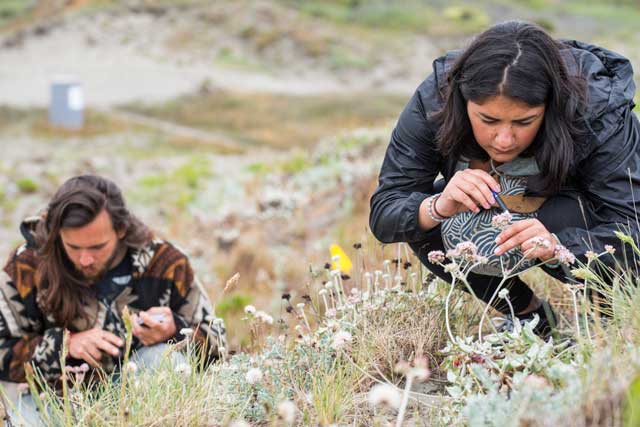
In the Wiyot language, rroulou’sik means “rising up.” The word is an emblematic name for a Humboldt State University internship program for Indigenous undergraduates from across the country to participate in experiential research in natural sciences at HSU. Throughout Northern California, many Indigenous tribes are actively engaged in managing their tribal resources, utilizing both Western and Indigenous science.
Funded by a grant from the National Science Foundation, the program operated for three consecutive years from 2016-2018. Each summer intensive was facilitated by Wildlife Professor Matt Johnson and Research Associate Seafha Ramos, an Indigenous scholar and National Science Foundation postdoctoral fellow in biology. Ramos’ current research project on elk habitat and TEK is the first formal study to address the combination of elk diet and habitat, as well as Indigenous science and cultural value of elk, to take place on the Yurok reservation.
Designed to provide Indigenous students an opportunity to actively participate in natural resources research, Rroulou’sik projects focused on a range of topics, such as an analysis of sea-level rise on Humboldt Bay waterfront infrastructure, an assessment of ecosystem health in the Eel River watershed, and strategies for supporting and empowering Karuk tribal youth in natural resources restoration and food security.
“The Rroulou’sik program had tremendous value because it allowed students to work collaboratively with HSU faculty members and tribal collaborators to do research that’s relevant to tribal communities,” says Johnson. He also explains that Rroulou’sik helped to advance the conversation at HSU about integrating TEK and conventional science.
Ramos, who is Yurok and Karuk, joined HSU after graduate school to serve as the Rroulou’sik coordinator and continues her work in the integration of TEK and conventional (Western) wildlife management approaches. In the course of her education, professional experience, and cultural involvement, Ramos has observed discrepancies between Indigenous and Western worldviews.
Today, she is the lead researcher of a collaborative project with Redwood National Park and the Yurok Tribe to explore Yurok TEK as related to meweehl (the Yurok word for elk) and to study elk habitat and diet via genetic analysis of fecal pellets.
Ramos embarked upon her research trajectory in TEK and wildlife conservation during graduate school, hoping to “understand how TEK and the Yurok-wildlife relationship are conceptualized in the Yurok cultural lens and to conduct applied wildlife research situated within an integrated context.”
“I think partnerships can be improved between agencies, universities, and tribes when TEK and Indigenous perspectives are included,” explains Ramos, who is also learning the Yurok language as a teacher candidate in the Yurok Tribe’s Kee Laa-yo-lue-mehl (“They will teach”) program.
Donald Moore (Yurok/Hupa) is a junior at Fort Lewis College in Durango, Colorado. During Rroulou’sik at HSU, Moore analyzed different aquaponics systems for pak choi production. “My project related to TEK and tribal land use by the way we used and took care of our resources,” explains Moore, who used the health of sturgeon to measure water quality. Moore entered the Rroulou’sik program as a History major but switched to Environmental Studies after the program. He credits the HSU program for opening up many new opportunities; currently, Moore works at his campus Environmental Center.
“I think Indigenous students might feel more supported when exposed to topics, worldviews, and science they can relate to,” says Ramos. She explains that while not every Rroulou’sik project involved TEK, each undergraduate who participated in the summer program self-identified as Native American, American Indian, Alaska Native, Pacific Islander or Hawaiian.
This month, ten former Rroulou’sik students will travel to Honolulu, Hawaii to participate in the 2019 Society for the Advancement of Chicanos and Native Americans in the Sciences (SACNAS) annual conference. Johnson and Ramos will attend to support the students and watch six students present on the results of their Rroulou’sik research projects. At the conference, Ramos will also participate in a career advancement workshop with her postdoc cohort, designed to support their navigation in science careers.
As an Indigenous scholar and scientist, Ramos has observed that the absence of diverse perspectives is not limited to undergraduates, but systemic throughout the sciences in higher education. In her research approach, aspects of both Indigenous and Western science have a role in answering important questions. While TEK is important to many tribal communities, often described as a “way of life,” Ramos explains that the academic field for TEK is relatively small.